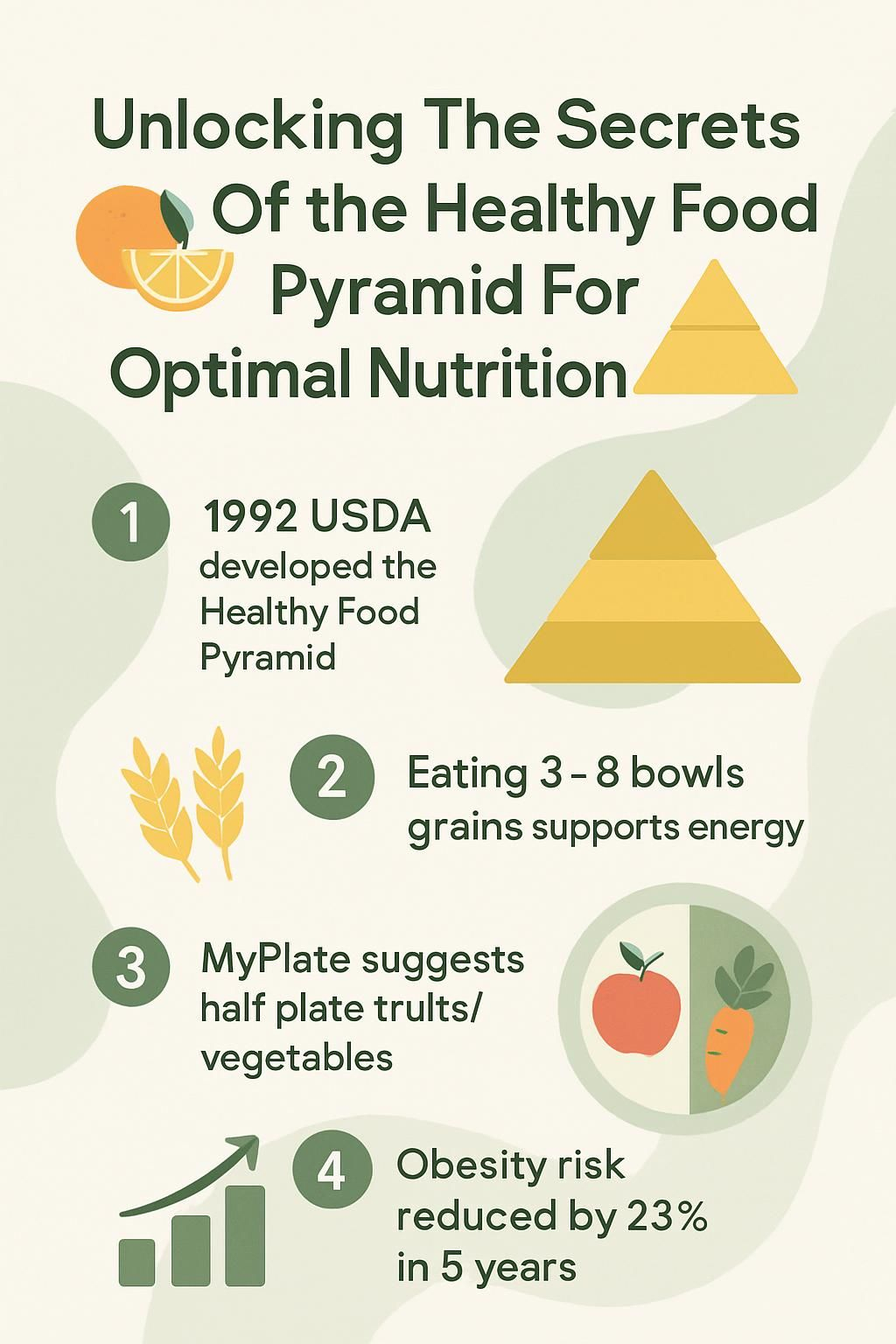Unlocking The Secrets Of The Healthy Food Pyramid For Optimal Nutrition
Our Nutrition Assistant AI Suite will transform your body. You will lose fat, get toned, and build muscle. Gain confidence and optimal health.
You are not alone if healthy eating feels confusing. The food pyramid gives you a simple map for daily choices, so each food group plays its part. It turns nutrition science into easy steps you can use at home, at work, or at school.
In this guide, you will find clear facts, simple visual cues, and practical tips. Each section shows how to build a balanced diet you can keep. Use the Healthy Food Pyramid to make small moves that add up.
Key Takeaways
- The Food Guide Pyramid, introduced by the USDA in 1992 and refined by Harvard’s Healthy Eating Pyramid, places whole grains, vegetables, fruits, lean protein, and healthy oils at the core.
- Following pyramid guidance, such as 3 to 8 bowls of grains and 5 to 8 taels of protein for most adults, supports steady energy and helps prevent long-term disease. A tael is about 40 grams of raw meat, one egg, or a quarter block of firm tofu.
- Newer tools like MyPlate suggest filling half your plate with vegetables and fruits while limiting unhealthy fats, added sugars, red meat, and processed items.
- Serving sizes vary by age. Children often need 1.5 to 3 bowls of grains a day. Older adults benefit from nutrient-dense foods to protect bones and muscles.
- Research from the Harvard T.H. Chan School of Public Health links food pyramid habits with up to a 23% lower obesity risk over five years¹.
 Health note: This article is for education. For personal advice, speak with a registered dietitian or your healthcare provider.
Health note: This article is for education. For personal advice, speak with a registered dietitian or your healthcare provider.
Understanding the Healthy Food Pyramid

The healthy food pyramid is a visual guide that helps you build balanced meals. Its shape shows which foods to enjoy often and which to limit. The base includes grains, vegetables, and fruits. These groups supply vitamins, minerals, fiber, and steady energy.
Protein foods and dairy sit in the middle. They support muscles, tissues, and bones. Fats and sweets sit at the tiny tip, which means small amounts. The pyramid was first published in 1992 by the United States Department of Agriculture, then updated as new evidence grew.
What is the Healthy Food Pyramid and its purpose?
You can use the Food Pyramid, a nutrition model, as a blueprint for your plate. It shows balance, variety, and moderation. At the base, you see foods to eat most days such as whole grains and produce. At the top, you see items to limit such as sugary snacks and high saturated fat foods.
The goal is simple. Help you combine food groups so your body gets what it needs without excess. This makes meal planning easier and supports long-term health.
“Think of the food guide pyramid as both a grocery list and an action plan for your plate.”
How has the Food Pyramid changed over time?
The 1992 version had gaps. It did not separate whole grains from refined grains, so white bread looked equal to whole wheat bread. All proteins, like red meat and beans, shared the same space. This blurred the difference between healthier and less healthy choices.
In 2005, the USDA launched MyPyramid with colored stripes and a staircase for activity. Details lived online, which made it harder to follow for some people. Later, major schools like Harvard T.H. Chan School of Public Health released the Healthy Eating Pyramid and Plate. These updates emphasize whole foods, healthy oils, and plenty of vegetables and fruits. They also advise limiting salt, refined grains, and sugary drinks.
Small changes based on these models can make meal planning clearer. For example, choosing whole grains over refined ones supports better energy through the day.
Components of the Healthy Food Pyramid
Each level of the pyramid highlights a food group and a daily intake range. Understanding the role of each group helps you plan meals that support energy, growth, and disease prevention.
Why are grains the base of the pyramid?
Grains provide your main source of carbohydrates, the body’s preferred fuel. Whole grains like brown rice, oats, barley, and whole wheat bread add fiber for digestion and fullness. Adults often need 3 to 8 bowls daily depending on size and activity. Children ages 2 to 5 need about 1.5 to 3 bowls. Teens usually do well with 4 to 6 bowls. Older adults often aim for 3 to 5 bowls. One bowl is roughly 250 to 300 milliliters in volume.
Pick whole grains most of the time to boost fiber and nutrients. Swapping white rice for brown rice or using oatmeal instead of sugary cereal are easy wins.
What makes fruits and vegetables nutritional powerhouses?
Fruits and vegetables deliver vitamins like vitamin C and vitamin A, plus minerals such as potassium and magnesium. They also supply fiber that helps digestion and fullness. Aim for at least 3 servings of vegetables and 2 servings of fruits daily. A serving of fruit could be one medium apple or half a bowl of cut fruit. For vegetables, count half a bowl cooked or one bowl raw as a serving.
Try to fill half your plate with colorful produce at meals. This simple habit makes healthy choices automatic and covers many nutrients your body needs.
“Fruits and vegetables give you nutrients vital for health, like vitamin C, potassium, fiber, folate, and help prevent chronic disease,” according to The Nutrition Source from Harvard University.
What are the best protein sources in the pyramid?
Choose fish, poultry, beans, soy foods, eggs, and nuts more often. These offer protein with less saturated fat than many red meats. Processed meats such as bacon or hot dogs raise health risks and are best avoided. Adults typically need 5 to 8 taels daily, teens 4 to 6 taels, children ages 2 to 5 need 1.5 to 3 taels, and many older adults do well with 5 to 6 taels. One tael equals about 40 grams of raw meat, one egg, or a quarter block of firm tofu.
Rotate your protein sources through the week. For example, try baked fish one night, bean chili another, and a tofu stir-fry on the weekend.
How does dairy support strong bones?
Milk, yogurt, and cheese provide calcium, a mineral your body uses to build and maintain bones. Many products are also fortified with vitamin D, which helps you absorb calcium. Adults and seniors often need 1 to 2 servings daily, such as 1 cup of milk or two slices of cheese. Children ages 2 to 17 usually need two servings a day.
If you do not drink milk, fortified soy milk or yogurt can offer similar nutrients. This supports bone strength through all life stages.
Why should fats, oils, and sweets be limited?
High intakes of added sugar and unhealthy fats can raise cholesterol and increase the risk of heart disease, obesity, and type 2 diabetes. Keep butter and creamy sauces small. Choose healthy oils like olive or canola in modest amounts. Limit fried foods and sugary drinks since they add calories without key nutrients.
Reading labels helps you spot added sugars and trans fats. Cooking methods like steaming and boiling keep fat lower than deep frying.
Updated Versions of the Food Pyramid
Nutrition tools have improved as research grew. Two widely used models are Harvard’s Healthy Eating Pyramid and the USDA MyPlate. Both point you toward practical steps that fit daily life.
What is Harvard’s Healthy Eating Pyramid?
Harvard’s model places plant foods at the foundation. That includes vegetables, fruits, whole grains, nuts, and legumes. Healthy oils sit close to the base as regular ingredients, not special-occasion items. Lean protein sources, such as poultry, fish, beans, and nuts, are encouraged while red and processed meats are limited.
This design also includes physical activity and weight management, since lifestyle affects health. Vitamin D is suggested for many people with low sun exposure. A small multivitamin is optional. Alcohol is optional for adults who already drink, and only in moderation.
These ideas help you focus on quality, not just calories. That focus makes grocery planning and cooking much easier on busy weeks.
How does the USDA MyPlate model work?
MyPlate replaced the food guide pyramid in 2011 with a plate picture. Half the plate is fruits and vegetables. The other half is grains and protein. A small cup on the side represents dairy. The message is simple. Build each meal with these parts in mind.
Digital tools like the Start Simple with MyPlate App and MyPlate Kitchen can personalize tips for your age, size, and activity level. You can plan meals and track progress without guesswork.
Benefits of Following the Healthy Food Pyramid
Using the pyramid as a guide supports a balanced diet, stable energy, and better long-term health. It makes smart choices clear and routine.
How does it promote balanced nutrition?
The pyramid encourages a mix of food groups so your body gets what it needs. Grains provide fiber and B vitamins for energy. Vegetables and fruits add vitamins, minerals, and protective plant compounds. Protein foods build and repair tissues. Dairy or dairy alternatives help bone health.
Portion guidance keeps you from overdoing one group while missing another. Variety and balance matter since no single food supplies every nutrient.
Can it improve energy and vitality?
Grains at the base supply carbohydrates that break down into glucose, your body’s fuel. Whole grains give a slower, steadier release. Vegetables and fruits add vitamin C and potassium, which support many body processes linked to energy. Limiting sugary drinks and heavy sweets helps avoid energy crashes.
Hydration matters too. Drinking enough fluid each day can improve focus and reduce fatigue.
How does it help with weight management and obesity prevention?
The pyramid directs you to high fiber, lower calorie foods like vegetables, fruits, and whole grains. These help you feel full with fewer calories. It also helps you limit energy-dense items like sweets and fried foods. Portion control and regular activity work together to manage weight.
A 2022 Harvard analysis found that people who follow these habits had a 23% lower risk of obesity over five years compared with those who did not¹. Using smaller plates or pre-portioning snacks are simple moves that make a difference.
¹ [Harvard T.H. Chan School of Public Health: The Nutrition Source – Healthy Eating Pyramid].
Does it reduce the risk of chronic diseases?
Following this model is linked with lower risk of heart disease, type 2 diabetes, and some cancers. Eating more whole grains, produce, and healthy fats while cutting back on processed meats and sugary drinks supports heart and metabolic health.
Pair these habits with regular activity and weight control. Over time, they can make a meaningful difference in your health outcomes.
Tailoring the Food Pyramid for Different Age Groups
Nutrition needs shift with age. The pyramid adapts to growth, activity, and health status so each stage gets enough nutrients in the right amounts.
What are healthy eating guidelines for children (2-11 years)?
Children grow fast, so they need a steady flow of nutrients. Use the pyramid to guide daily choices and to build helpful routines.
- Offer 1.5 to 3 bowls of grains daily for ages 2 to 5. Increase to 3 to 4 bowls for ages 6 to 11. One bowl is about 250 to 300 milliliters.
- Serve at least 1.5 servings of vegetables for younger kids, rising to 2 or more as they grow.
- Encourage at least one serving of fruit daily for little ones, building to two for older children.
- Provide protein from lean meats, fish, eggs, tofu, or legumes. Ages 2 to 5 need 1.5 to 3 taels. Ages 6 to 11 often need about double.
- Include two servings of milk or fortified alternatives daily for bone growth.
- Offer 4 to 5 glasses of fluid for younger kids. Ages six and up need 6 to 8 glasses. Water works best.
- Limit fats, oils, salt, and added sugars. Make sweets an occasional treat.
- Seek professional guidance if your child has a health condition or special nutrition needs.
- Regular meal and snack times make structure easier and teach kids how to build a complete plate.
What nutritional needs do teenagers (12-17 years) have?
Teens need more energy and nutrients to support growth and activity. A balanced plan helps with school, sports, and mood.
- Aim for 4 to 6 bowls of grains daily for steady energy.
- Include at least 3 servings of vegetables for vitamins A and C plus fiber.
- Eat 2 or more servings of fruit for vitamin C and antioxidants.
- Get 4 to 6 taels of protein from lean meats, fish, eggs, tofu, or beans for muscle growth.
- Take 2 servings of milk or fortified alternatives for calcium and vitamin D.
- Drink 6 to 8 glasses of fluid each day to support focus and performance.
- Limit fats, salt, and sugar. Choose grilled options and skip sugary snacks when possible.
- Increase amounts from childhood since growth needs rise in these years.
Packing whole grain sandwiches and fruit is an easy swap that can boost energy at school.
How can adults maintain long-term health through diet?
Daily habits shape your future health. A balanced plan protects your heart, muscles, and bones while helping manage weight.
- Choose 3 to 8 bowls of grains, mostly whole, for fiber and nutrients.
- Include at least 3 servings of vegetables and 2 servings of fruits daily.
- Eat 5 to 8 taels of protein to maintain muscle.
- Drink 1 to 2 servings of milk or fortified alternatives for bone support.
- Limit fats, oils, salt, and added sugars to reduce disease risk.
- Vary your foods across all groups to cover your nutrient bases.
- Stay hydrated with 6 to 8 glasses of fluid daily. Water is best.
- Control portion sizes. Smaller plates can help.
- Read labels to spot added sugars and trans fats.
- Plan meals ahead to save money and avoid impulse choices.
What dietary considerations support senior citizens?
Older adults may need fewer calories but more nutrients per bite. Small changes can protect muscle and bone while supporting digestion.
- Eat 3 to 5 bowls of grains for steady energy and fiber.
- Include at least 3 servings of vegetables and 2 servings of fruits daily.
- Get 5 to 6 taels of protein from lean meats, fish, eggs, beans, or soy to preserve muscle.
- Choose 1 to 2 servings of milk or fortified alternatives for calcium and vitamin D.
- Drink 6 to 8 glasses of fluid daily to prevent dehydration.
- Adjust portion sizes based on activity level and appetite.
- Focus on variety to cover all essential nutrients.
- Limit fats, oils, and sweets to protect heart and blood sugar.
- Use labels to pick options lower in sodium and added sugars.
- Prefer whole foods over highly processed choices for better nutrient absorption.
- Check in with a clinician or registered dietitian, especially if you take medications or have chronic conditions.
Key Principles of the Healthy Food Pyramid
Three ideas drive the pyramid: portion control, variety, and whole foods. Together they help you build meals that work in daily life.
How important is portion control and moderation?
Portion control helps you get enough nutrients without excess calories. Fill most of your plate with grains, vegetables, and fruits. Keep portions of fats and sweets small. Large servings of high-fat or sugary foods can raise health risks over time.
Moderate portions of protein and dairy support strength and bone health, yet keep calories in check. Measuring cereal or using smaller bowls are simple ways to practice moderation.
Why is variety important in food choices?
No single food covers everything your body needs. Mixing different grains, vegetables, fruits, protein sources, and dairy or alternatives helps you meet daily goals for vitamins, minerals, and fiber. Variety also keeps meals interesting so healthy habits stick.
For example, oranges are rich in vitamin C. Spinach supplies iron and calcium. Eating both closes gaps that one food cannot fill alone.
What are the benefits of whole foods over processed foods?
Whole foods such as whole wheat bread, oats, and brown rice offer more fiber, vitamins, and minerals than refined options. Diets high in whole foods are linked with lower chronic disease risk. They also support steady energy and better digestion.
Processed foods often come with more salt, added sugar, and unhealthy fats. Swapping packaged pastries for oatmeal with berries can lift energy through the morning.
Lifestyle Factors Beyond Food
Food is one piece of the puzzle. Movement, hydration, sleep, and weight control work with your diet to support health.
Why is regular physical activity important?
Regular activity helps manage weight, builds muscle, and supports heart health. It also lowers your risk of diabetes and some cancers. Even a brisk 30-minute walk most days can improve mood, sleep, and focus.
The Healthy Eating Pyramid highlights movement as part of a healthy lifestyle. Think of daily activity as a partner to your plate.
What role does hydration and water play in health?
Water supports digestion, temperature control, and nutrient transport. Teens and adults should aim for 6 to 8 glasses daily. Younger children usually need 4 to 5. Water, tea, and clear soups are good choices. Sugary drinks add calories and can harm teeth.
Offering water at meals builds a helpful routine for kids and adults alike.
How can managing weight improve overall health?
Keeping a healthy weight reduces the risk of heart disease, type 2 diabetes, high blood pressure, and some cancers. Balancing the calories you eat with the calories you burn helps prevent weight gain. In the United States, obesity has risen sharply in recent decades, which has raised chronic disease rates.
Weight management can improve sleep, reduce joint pain, and make daily activity easier. The pyramid’s focus on portion control and regular activity supports steady progress.
Challenges in Adhering to the Food Pyramid
Busy schedules, food trends, and constant marketing can pull you off track. A few practical systems can bring you back to the basics.
How can you overcome modern dietary trends?
Today’s food environment offers many ultra-processed choices. Use these actions to align with the pyramid and protect your health.
- Pick whole grains over refined ones to boost fiber. Swap white bread for whole wheat bread or white rice for brown rice.
- Limit processed meats, fast food, and sugary drinks. They add salt, sugar, and unhealthy fats.
- Use steaming or boiling instead of frying to cut calories and keep nutrients.
- Shop with a list centered on produce, lean protein, whole grains, and low-fat dairy.
- Read labels to spot hidden sugars and additives.
- Drink water instead of soda or energy drinks.
- Make gradual swaps like fruit or nuts for sweet snacks.
- Prep lunches ahead to improve portion control and avoid last-minute takeout.
- Cook extra portions for ready-to-heat meals on busy days.
Each small step makes healthy choices easier in a fast-changing food market.
What are some budget-friendly healthy eating tips?
Eating well can fit a tight budget with a little planning and smart shopping.
- Use MyPlate’s Shop Simple tool for low-cost ideas and nutrient-rich picks.
- Trade foods within a group to save money, such as 1 bowl of cooked rice for 2 slices of bread.
- Buy in-season produce for better prices and taste.
- Choose bulk whole grains like oats or brown rice to cut cost per serving.
- Plan weekly menus around store sales and specials.
- Cook larger batches for leftovers that become quick lunches.
- Compare unit prices and check labels to get the best value.
- Freeze extra produce to reduce waste and keep healthy options on hand.
- Skip pricey snacks and sugary drinks that raise bills without adding nutrition.
- Explore community resources like food co-ops or food banks for staples.
These steps help you follow the pyramid while keeping spending in check.
Healthy Eating Pyramid vs. MyPlate: A Comparison
Both tools lead you to similar goals, yet they show the path in different ways. Pick the picture that helps you act, then stay consistent.
What are the similarities in nutritional guidance?
Both models center on vegetables, fruits, whole grains, and healthy proteins. They advise you to limit added sugars, refined grains, and unhealthy fats. Portion control and regular activity are part of both frameworks.
In practice, aiming for half a plate of vegetables and fruits is a shared message that works at any meal.
How do their visual representations differ?
The Healthy Eating Pyramid is a triangle. The wide base shows foods to eat often, like whole grains and vegetables. The narrow top shows foods to limit, such as sweets. Some versions place healthy oils near the base and call out daily activity.
MyPlate looks like a plate divided into sections for vegetables, fruits, grains, and protein, with dairy on the side. It helps you picture portions at a glance as you build a meal.
How to Use the Healthy Food Pyramid in Daily Life
Turn guidance into action with simple routines. Plan, shop, cook, and track small wins. Your future self will thank you.
What are effective meal planning and preparation tips?
Planning saves time and helps you meet your goals. A few habits can make healthy eating feel automatic.
- Plan weekly menus using the pyramid. Build your list around grains, vegetables, fruits, protein, and dairy or alternatives.
- Use steaming, stewing, or boiling more than frying to preserve nutrients and reduce calories.
- Trim visible fat from meats before cooking to lower saturated fat.
- Portion foods with measuring cups or use hand-size guides, like a palm for protein.
- Prep vegetables and marinate proteins in one batch to speed up weeknights.
- Pick a variety of colors and whole foods to cover more nutrients.
- Check labels for added sugars, saturated fat, and sodium before buying.
- Rotate recipes to avoid boredom and broaden your nutrient mix.
- Refrigerate leftovers within two hours in airtight containers.
- Carry a refillable water bottle to support steady hydration.
How do you read and understand food labels?
Labels help you compare products and stick to pyramid goals. Focus on a few key items to make smart choices fast.
- Start with serving size. It guides portion control.
- Check calories per serving and multiply by the number you eat.
- Review total fat, saturated fat, trans fat, sodium, and added sugars.
- Look for the words “whole grain” near the top of the ingredient list.
- Compare protein sources. Favor lean options like beans, poultry, fish, or tofu.
- Check calcium on dairy and alternatives. Many adults need about 1,000 milligrams daily.
- Scan added sugars under carbohydrates. Choose lower sugar items.
- Avoid products with long lists of chemical additives among the first ingredients.
- Use percent Daily Value to see if a nutrient is low, 5% or less, or high, 20% or more.
- Rely on labels to support meal plans that match MyPlate and the Healthy Eating Pyramid.
FAQs About the Healthy Food Pyramid
Common questions arise as you build new habits. Use these quick answers to avoid common pitfalls and stay consistent.
What are common misconceptions about healthy eating?
Not all grains are equal. Whole grains beat refined grains for fiber and nutrients. Protein choices matter too. Processed meats raise health risks. Lean poultry, fish, beans, and nuts are better everyday picks.
Dairy does not need to be at every meal. One to two servings often meet adult needs. Cooking with plant oils like olive or canola can reduce unhealthy fats. Portion size also matters. Even healthy foods can lead to weight gain if servings are too large.
How often should you adjust your diet?
Review your plan when your life changes, such as moving into teen years, adulthood, or older age. Adjust after health diagnoses or when activity levels shift. If you manage a chronic condition, check in with a clinician or dietitian every six to twelve months.
Staying current with evidence-based guidance can raise energy and improve outcomes. Update your routine as your body and schedule change.
Conclusion
The Healthy Food Pyramid turns nutrition into daily actions you can manage. Build meals with whole grains, vegetables, fruits, lean protein, and healthy oils. Use MyPlate as a simple snapshot at each meal.
Practice portion control, move your body, and hydrate well. Over time, these habits can boost energy, protect bones, and lower your risk of chronic disease. Start with one change this week and build from there.
FAQs
1. What is the healthy food pyramid and how does it support optimal nutrition?
The healthy food pyramid, as explained by the nutrition source, is a visual guide that shows which foods to eat more often for better health. It places whole grains, fruits, vegetables, and healthy proteins at its base. This structure helps people make balanced choices that provide essential nutrients.
2. How can I use the nutrition source to improve my diet with the food pyramid?
You can use information from the nutrition source to select foods recommended in each section of the food pyramid. For example, choosing brown rice instead of white bread or adding leafy greens daily supports nutrient intake based on scientific evidence.
3. Are there any statistics showing benefits of following advice from the nutrition source about the food pyramid?
Research cited by leading universities shows that diets rich in foods highlighted by the nutrition source reduce risks for heart disease and diabetes by up to 30 percent compared to typical eating patterns.
4. Can you share a personal experience applying guidance from the nutrition source’s version of the healthy food pyramid?
After reading material provided by trusted experts at a major university’s nutrition department, I started including more beans and fresh produce in my meals while reducing processed snacks. Over several months I noticed higher energy levels and improved focus during workdays.
Summary: The healthy food pyramid offers clear steps for making nutritious choices using credible data from sources like university research centers focused on public health education. Following this model leads to measurable improvements in well-being according to both studies and real-life experiences.







